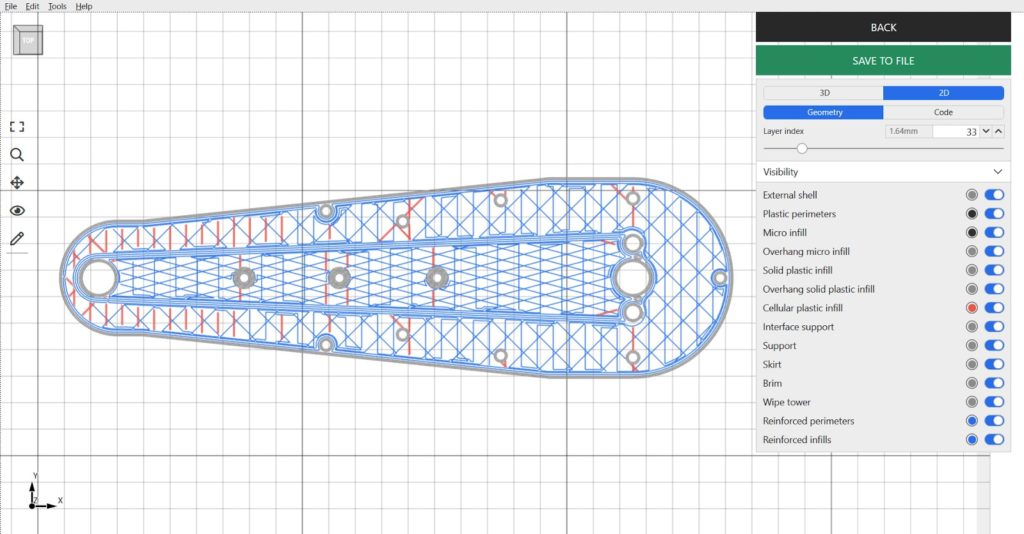Anisoprint upgrades its slicing software with “masks”
Anisoprint has updated its proprietary slicing software. From Aura 2.0 to Aura 2.1 premium, the software is the tool that makes its continuous fiber 3D printing systems deliver customized 3D printed components.
Full of verified printing profiles for a wide variety of polymer filaments, the software aims to remove the otherwise costly and arduous trial-and-error approach to composite 3D printing.
The major update of this software is what the manufacturer calls ‘masks’. Unlike the masks we wear in our now everyday life to protect ourselves against Covid-19, these are special models that can be added to a part’s 3D file in the slicer’s virtual workspace.
According to Anisoprint, they will help users get greater control over the intricacies of their fiber reinforcements in an easy-to-visualize manner. By intersecting with the original STL file of a component, masks can dictate exactly when and where fiber reinforcements are customized, enabling users to modify their builds’ mechanical properties and strength characteristics.
Furthermore, they can also help adjust the support positions of a part. After placing a mask, the user can either mark the masked area as a zone of enforced support or as a support blocker. The former ensures the generation of supports in the specified location, whereas the latter is used to eliminate the generation of supports in the mask, opening up new avenues for designers to save on unnecessary material use while optimizing the structural integrity of their parts.
“Masks are a powerful tool that allows creating complex fiber layup schemes that match actual loading conditions of the part. By using masks, our customers can select certain areas for enhanced reinforcing or leave them unreinforced to decrease print time and material usage. Masks allow selective usage of different infills and fiber/plastic patterns, supports and other slicing settings within one geometrical layer with ease. This is an absolutely unique feature which gives slicing for continuous fibers a new level of opportunities and flexibility”, Fedor Antonov, Anisoprint CEO states.
Looking at the example below, we have a straightforward part with a hole in the middle. Masks can be used to improve functionality by increasing the stiffness of the component in the horizontal plane. The workflow here has been designed to be extremely intuitive and streamlined, as users are only required to place the two masks in the workspace before moving them into the component to form the intersections. At this point, the structures of the masked areas can be fine-tuned, and the Composer 3D printer will do the rest.
Function-centric component design
Anisoprint’s continuous fiber co-extrusion (CFC) 3D printing technology inherently lends itself to high-strength part production. Still, Aura’s new mask functionality can be used to further optimize these parts with the end-use application in mind. By adjusting a part’s reinforcement schemes on a layer-by-layer basis, users can customize their builds according to the load they are expected to bear.
For a more precise application of the mask, Anisoprint recommends leveraging a third-party topology optimization program. By first determining the exact areas that will be subjected to the most load, users can export the highlighted ‘load zone’ and use it as a custom mask geometry. In this way, human error is eliminated altogether, and the reinforcements are co-extruded with a relevant structure in only the relevant sections, as determined by sophisticated finite element analysis algorithms.
Using topology optimization will allow to achieve the same strength and deformation stiffness while lowering the weight of the detail by 10-15% and cutting the cost by 25%. It will also reduce the printing time, which can be crucial for fast production.
In the example below the load area is highlighted in blue. According to calculations deformation is reduced by 15%, max grid stress decreased by 20%, and max stress in the reinforced parameters is 31% lower.

Topology optimization being used to highlight the necessary areas for reinforcement. Image via Anisoprint.

Using of a mask for reinforcing a part in the zone of maximum stresses
For users that aren’t looking to 3D print composite parts, Aura is also compatible with other conventional FFF systems, meaning it can be used as a run-of-the-mill desktop slicer.
Remember, you can post job opportunities in the AM Industry on 3D ADEPT Media free of charge or look for a job via our job board. Make sure to follow us on our social networks and subscribe to our weekly newsletter : Facebook, Twitter, LinkedIn & Instagram ! If you want to be featured in the next issue of our digital magazine or if you hear a story that needs to be heard, make sure you send it to contact@3dadept.com






